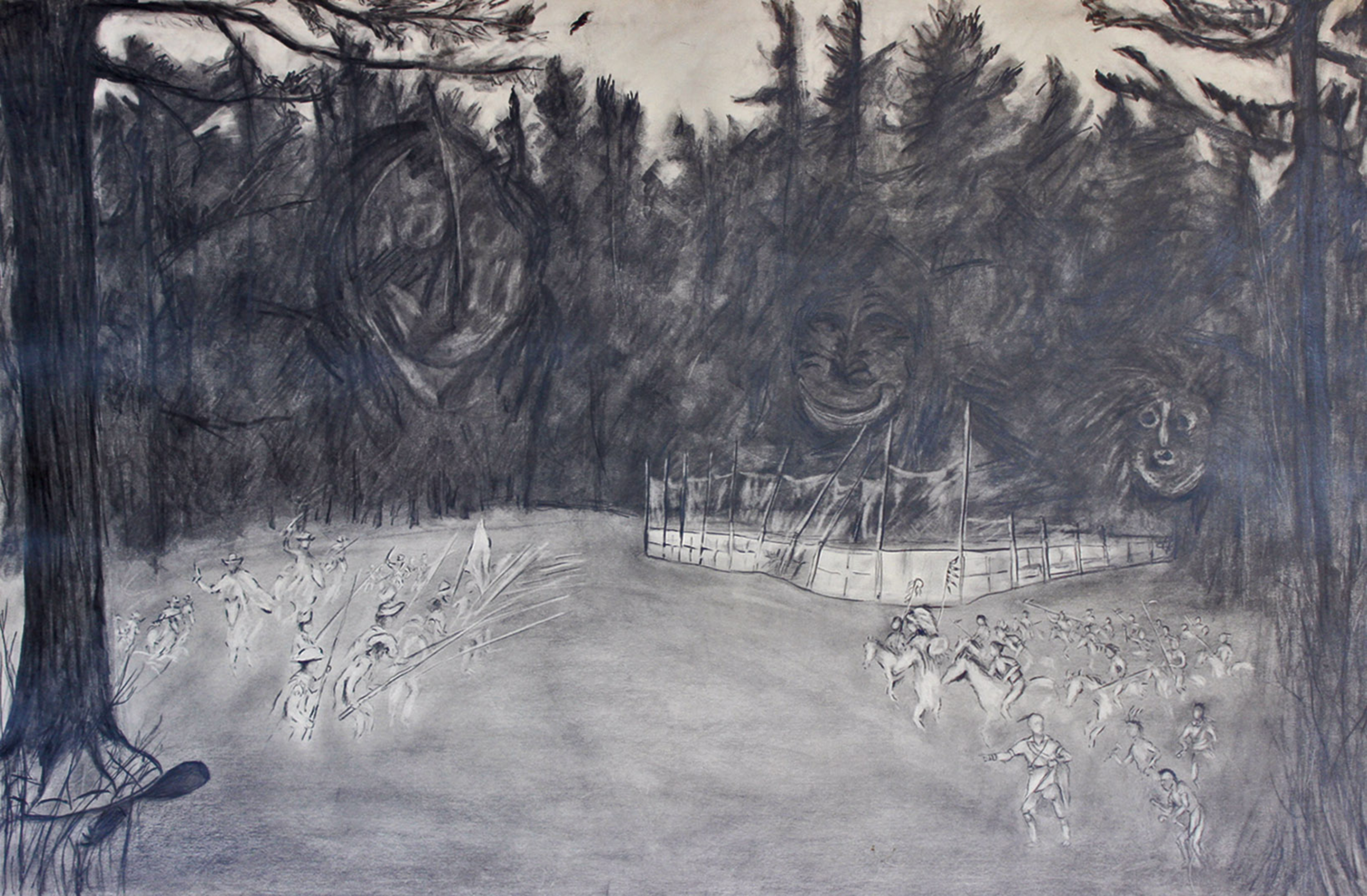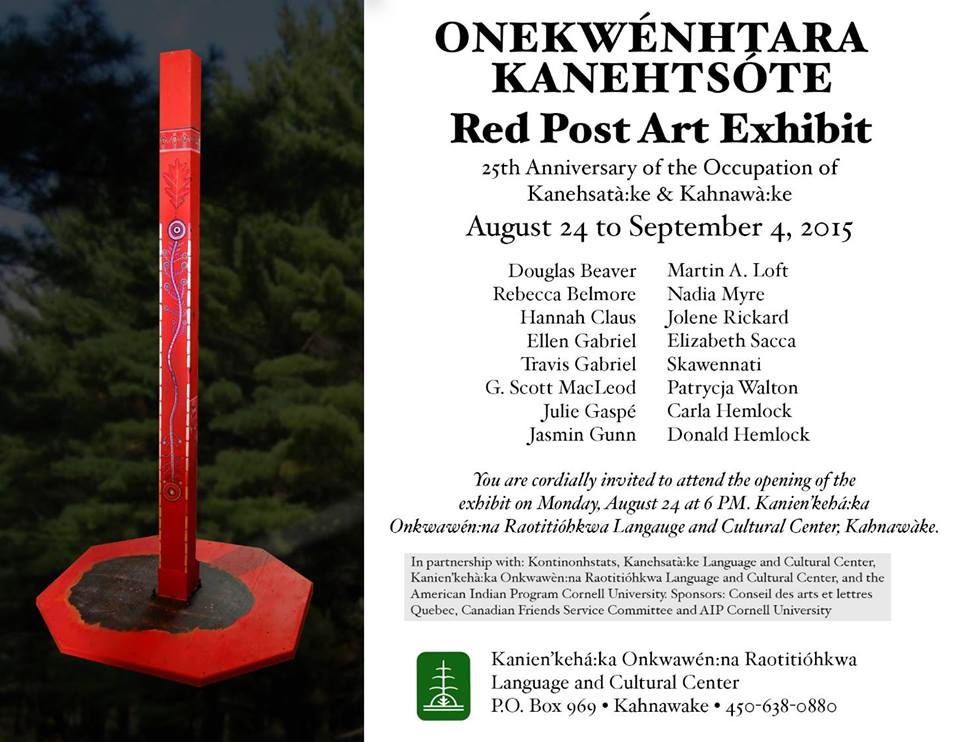Like this article? rabble is reader-supported journalism. Chip in to keep stories like these coming.
Onekwenhtara Kanehtsote – the Red Post Art Exhibit, curated by Katsi’tsakwas Ellen Gabriel of Kanehsatà:ke and Jolene Rickard of Tuscarora, commemorates the 25th anniversary of the Crisis of 1990, also known as the Oka Crisis, by demonstrating its impacts through art.
This exhibit brings together the work of 16 artists, both Indigenous and non-Indigenous, who have reflected on their experience of the Crisis of 1990. In some cases, artworks reflect first-hand experiences of Kanehsatà:ke residents, and in other cases artworks reflect on the long-term impacts of the Crisis.
The Crisis of 1990 began with a peaceful protest against plans by the town of Oka, Quebec to expand a private nine-hole golf course. The expansion would destroy part of a mature pine forest in Kanehsatà:ke and required the destruction of the Kanien’kehá:ka (Mohawk) community graveyard. The peaceful protest escalated when the Kanien’kehá:ka people of Kanehsatà:ke were surrounded by the Quebec provincial police on July 11, 1990.
Many of the artists represented in the exhibit are Kanien’kehá:ka from Kanehsatà:ke and Kahnawake, a Kanien’kehá:ka community which was also involved in the Crisis.
The exhibit offers visitors an opportunity to reflect on the effects of the conflict on the people who were personally involved, as well as the impact on Indigenous and non-Indigenous societies and politics across the continent.
In the centre of the exhibit is the red post itself, an installation piece created by Katsi’tsakwas Ellen Gabriel. The red post refers to the Haudenosaunee (People of the Longhouse) practice of erecting a red post in communities during times of conflict or war.
Gabriel’s installation, a post painted red, a colour signifying power and war, reminds us of the Kanien’kehá:ka people’s long history, one that began long before European settlement and continues into the present. The symbols depicted on the post include wampum beads, corn, a war club and the tree of life.
At the top is a circle of people holding hands, united in protecting the land. These symbols emphasize the richness and longevity of Kanien’kehá:ka culture and calls into question the settler notion that Indigenous people belong only to the past, or that their cultures and political systems have no role to play in the modern world.
The red post also reminds those entering the exhibit of the long-standing and unresolved conflict over land rights that grew into the Crisis of 1990 and remains unresolved today. The pine forest where the conflict took place is considered by the municipality of Oka to belong to the town. However, the Kanien’kehá:ka never ceded the land that is now Kanehsatà:ke (includes the Pines).

Among the artworks contributed by artists from Kanehsatà:ke is Douglas Tehonietathe Beaver’s backpack called “Pelt and Pine, Armed with Healing.” This work alludes to a soldier’s pack, and reminds viewers of the Canadian Army soldiers who surrounded Kanien’kehá:ka s in 1990. But instead of being filled with ammunition, grenades and guns, this backpack is “armed” with an eagle feather, a sweet grass braid, a cedar smudge stick and pot, and other items related to spiritual healing, presenting an alternative response to land conflict both in Kanehsatà:ke and elsewhere.
Another artwork emphasizing the importance of Haudenosaunee culture is a quilt called “Sky Woman’s Descent” by Carla Hemlock, a Kanien’kehá:ka of Kahnawake. The story of Sky Woman is the creation story of the Haudenosaunee people — Sky Woman descends into our world and lands on the back of a turtle that transforms, with the help of various animals, into North America. In this blue, gold and black beaded quilt, we see the back of the turtle from the perspective of Sky Woman as she descends.
Elizabeth Saccà, a non-Indigenous artist and retired Concordia University professor who lives near Kanehsatà:ke, contributed an abstract monotype called “Maelstrom.” For this viewer, this print evokes the confusion and disorientation that must have reigned in the Pines when the Quebec police first attacked Kanehsatà:ke with tear gas and smoke bombs. It also represents the ever-present potential for violence that Indigenous people face when they protest land development on their territories.
Nadia Myre, an Algonquin artist based in Montreal, contributed “Still Life,” an ink print depicting two protesters in silhouette with flags. The image connects the Red Post exhibit to the broader history of Indigenous social and land justice issues and brings to life the widespread support for Indigenous sovereignty manifested nation-wide in the form of demonstrations, blockades and flash mobs, as well as Idle No More.

Along with these artworks, pieces include Patrycja Walton‘s “Dress for Amicee,” a sculpture of a dress made of animal hide, wire and stain glass, and dedicated to missing Aboriginal women and girls, including her friend Amicee. Julie Otsi’tsaonwe Gaspé’s created her untitled graphite drawing of the Pines before the protests against development turned into an armed conflict. Her prophetic drawing depicts a conflict between Indigenous and non-Indigenous people in the Pines, while above them in the trees, faces look down, watching the conflict unfold.
Onekwenhtara Kanehtsote – The Red Post exhibit moves from Kanehsatà:ke to Kahnawake, Quebec. Visitors are invited to reflect on these works and on the impact of the Crisis of 1990 at the Kanien’kehá:ka Onkwawén:na Raotitióhkwa Language and Cultural Centre from August 24 to September 4. The Vernissage is on August 24 at 6 PM.
To learn more about the impacts of the Oka Crisis, and to hear a discussion by the exhibit’s curators and some of its featured artists, check out the webinar: 25 Years Later, Impacts of the Oka Crisis.
Jennifer Dales is a writer living in Ottawa. She writes about Aboriginal issues, especially related to art and health. She also writes on online privacy issues. Her work has appeared in the Canadian Medical Association Journal, Arc Poetry Magazine, rabble.ca and The Danforth Review. Her poetry has appeared in several journals, including Prairie Fire and Arc. She blogs at marchwinds.wordpress.com, and tells stories at cowbird.com/marchwinds/stories.
Photos used with permission from the artists.



